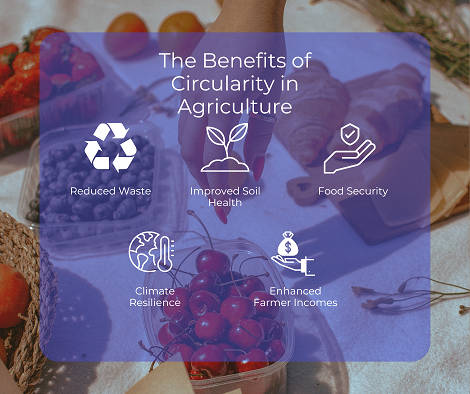Contact: +91 99725 24322 |
Menu
Menu
Quick summary: Delve into the world of circular agriculture with our knowledgeable expert. Discover the strategies and benefits of resource efficiency, waste reduction, increased resilience, and sustainable farming practices. Join us on the path to a greener future.

A strategy known as circularity in agriculture tries to shut resource loops within the agricultural system, minimizing waste and maximizing resource efficiency. It entails developing farming methods and systems that reflect natural cycles, lessen reliance on finite resources, and support sustainable and regenerative practices.
According to FAO, around one-third of all food produced for human consumption is lost or wasted globally, amounting to approximately 1.3 billion metric tonnes per year.
Today when resource scarcity and environmental concerns are becoming increasingly pressing, concept of circularity has gained significant attention. An economic model known as the “circular economy” seeks to reduce waste, increase resource efficiency, and advance sustainability. The old linear economy, which has a “take-make-dispose” structure, is sought to be replaced with one that closes the loop by preserving resources for as long as possible.
Agriculture being one of the largest users of natural resources ad contributors to environmental impact, holds immense potential for circular practices. Circular agriculture focusses on optimizing resource utilization, minimizing waste and fostering sustainable food production. In this blog we delve into the concept of circularity in agriculture, exploring its principles, benefits and innovative approaches that are transforming the way we produce and consume food.
In agriculture or circular economy for food it is a system of regeneration that aims to minimize waste by making the most out of resources available. It aims to keep the supply chain in a closed loop of maximizing product life and reducing waste.

A more ecologically friendly and sustainable agricultural system is made possible through circular agriculture by minimizing waste output, improving resource usage, and lowering pollution. It contributes to the preservation of natural resources, lessens the negative effects of agriculture on ecosystems, and promotes the general welfare of both people and the environment.
Circular agriculture practices that improve soil health improve soil fertility, nutrient availability, water retention, and microbial activity. A sustainable agricultural output depends on healthy soils because they promote plant growth, increase crop resistance to pests and diseases, and support plant growth. Furthermore, by functioning as a carbon sink and trapping carbon dioxide from the atmosphere, healthy soils help to mitigate climate change.
Circular agriculture increases ecosystem resilience, pest and disease control, and overall ecological balance by fostering biodiversity. Pollination services, healthy soil, clean water, and the long-term viability of agricultural systems are all benefits of biodiversity in agricultural environments. Aside from supporting cultural and recreational activities, the existence of various habitats and species improves the aesthetic value of agricultural landscapes.
Circular agriculture assists farmers in adapting to the effects of climate change, lowering risks, and maintaining agricultural productivity in the face of shifting climatic conditions. By assuring food security and the ability of farming communities to support themselves, it supports the general sustainability and long-term viability of agricultural systems.
Food systems may become more productive, robust, and sustainable by implementing circular agriculture ideas and practises, which will ultimately improve food security on a local, national, and international scale. Circular agriculture promotes the availability, affordability, and accessibility of wholesome food, enhancing the livelihoods and general well-being of communities all over the world.
In general, circular agriculture boosts the economy by enhancing resource efficiency, lowering input costs, boosting output, gaining access to specialized markets, and fostering resilience. Smallholder Farmers can increase their financial success, long-term viability, and economic sustainability in a changing agricultural environment by implementing circular practices.
The practice of circular agriculture includes agroforestry. It is a crucial element that supports the resilience and sustainability of agricultural systems.
Agroforestry within circular agriculture practices improves biodiversity, soil health, climate resilience, and economic potential by incorporating trees into agricultural landscapes. By maximizing resource utilization, enhancing ecosystem processes, and assisting resilient and sustainable agricultural systems, it serves as an excellent example of circularity.
Crop rotation is one of the circular agriculture practices that farmers can use to better manage pests, nutrient cycling, soil health, and risk. It promotes long-term sustainability, lessens dependency on chemical inputs, and supports resilient and effective agricultural systems.
Composting is an efficient and sustainable circular agriculture practice that promotes waste reduction, improved soil health, and overall agricultural system sustainability. It encourages more resource-saving and regenerative farming techniques, supports nutrient recycling, and lessens its negative environmental effects.
Agronomic practices that emphasize producing crops and livestock without the use of synthetic chemicals, genetically modified organisms (GMOs), or artificial additions are known as organic farming. It is founded on ideas that support healthy soil, biodiversity, ecological balance, and resource management that is sustainable.
Regenerative agriculture is a comprehensive and systems-based method of farming with the objective of regenerating the ecosystem services and natural resources essential to agriculture. By actively reviving the soil and encouraging cyclical cycles of growth and renewal, it goes beyond sustainable practices. Regenerative agriculture offers the possibility for sustainable and regenerative food production systems by placing a priority on soil health, biodiversity, and climate resilience.
Promoting the widespread adoption of circular agriculture, organic farming, regenerative agriculture, and other sustainable practices requires addressing the lack of knowledge and education in sustainable agriculture. Stakeholders may collaborate to overcome these obstacles and promote a more sustainable and resilient agriculture industry by raising awareness, enhancing access to information and resources, offering training opportunities, and enacting supportive legislation.
Resistance to change is a common barrier to adopting sustainable agricultural practices, including circular agriculture, organic farming, and regenerative agriculture. People may be reluctant to change established routines, technologies, or mindsets due to various reasons.
The implementation of sustainable agriculture practices is significantly hampered by a lack of money and infrastructure. Circular agriculture, organic farming, and regenerative agriculture are examples of practices that may be difficult to implement and expand due to inadequate infrastructure and financial resources.
Improving market information systems, investing in market infrastructure, assisting certification processes, fostering market linkages, and developing supportive policy frameworks are just a few of the actions needed to address limited market access. For the development of a thriving and inclusive market ecosystem for sustainable agricultural products, cooperation between government organizations, private sector stakeholders, farmer organizations, and civil society is crucial.
TraceX’s blockchain traceability and sustainability platform plays a vital role in promoting circularity in agriculture by enhancing transparency, efficiency and accountability in the food supply chain.
In summary, circular agriculture is a strategy that tries to develop a closed-loop system in agriculture where resources are utilized effectively, waste is decreased, and environmental concerns are lessened. Crop rotation, agroforestry, composting, and organic farming are a few of the techniques used, all of which improve the overall sustainability and resilience of agricultural systems.
Numerous advantages of circular agriculture include decreased waste and pollution, higher resilience to climate change, increased biodiversity, improved soil health, increased food security, and financial gains for farmers.
Circularity in agriculture is not just a concept but a necessity for building a sustainable and resilient food system.
